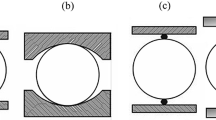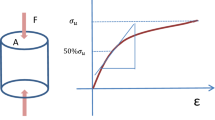Summary
The Brazilian test is a widely accepted method for the determination of the tensile strength of intact rock. Specifications for the Brazilian tensile strength test have been established by the American Society for Testing and Materials (ASTM), ASTM D 3967-86 and a suggested approach is provided by the International Society for Rock Mechanics (ISRM). The ASTM and ISRM allow a relatively wide range of values for specimen geometry defined in terms of length to diameter ratio and loading rates defined as either time to failure or stress rate.
A statistical study was carried out on a coal measure sandstone to determine whether the tensile strength determined by the Brazilian test is independent of the specimen geometry and the stress rate.
Similar content being viewed by others
References
Akazawa, T. (1953): Tension Test Method for Concrete. Union of Testing and Research for Materials and Structures, No. 16.
American Society for Testing and Materials (1988): Standard Method for Splitting Tensile Strength of Intact Rock Core Specimens D 3967-86. 1988 Annual Book of ASTM Standards, Vol. 04.08, Soil and Rock; Building Stones; Geotextiles, 471–475.
Caneiro, F. (1947): Une Novelle Methode d'essai pour Deternirer la Resistance a la Traction du Beton. Reunion des Laboratorires d'Essai de Materiaux, Paris.
Chew, V. (1976): Comparing Treatment Means: a Compendium. Hortscience11 (49), 348–357.
Greminger, M. (1982): Experimental Studies of the Influence of Rock Anisotropy on the Size and Shape Effects in Point Load Testing. International Journal of Rock Mechanics and Mining Sciences and Geomechanical Abstracts19, No. 5, 241–246.
International Society for Rock Mechanics: Suggested Methods for Determining Tensile Strength of Rock Materials. International Journal of Rock Mechanics and Mining Sciences and Geomechanical Abstracts15, No. 3, 99–103.
Mattson, D. E. (1981): Statistics: Difficult Concepts, Understandable Explanations, The C. V. Mosby Company, St. Louis, 482 pp.
Rouleau, A., Gale, J. E. (1985): Statistical Characterization of the Stripa Granite, Sweden. International Journal of Rock Mechanics and Mining Sciences and Geomechanical Abstracts22, No. 6, 353–367.
Snedecor, G. W., Cochran, W. G. (1980): Statistical Methods. 7th ed., The Iowa State University Press, Ames, Iowa, 507 pp.
Walpole, R. E., Myers, R. H. (1978): Probability and Statistics for Engineers and Scientists. Second Edition. Macmillan Publishing Co., Inc., New York, 580 p.
Yamaguchi, U. (1970): The Number of Test Pieces Required to Determine the Strength of Rock. International Journal of Rock Mechanics and Mining Sciences7, No. 2, 209–227.
Author information
Authors and Affiliations
Rights and permissions
About this article
Cite this article
Newman, D.A., Bennett, D.G. The effect of specimen size and stress rate for the Brazilian test—A statistical analysis. Rock Mech Rock Engng 23, 123–134 (1990). https://doi.org/10.1007/BF01020397
Issue Date:
DOI: https://doi.org/10.1007/BF01020397




